How fat and salt impact cheese drying and taste
National Cheese Day on June 3rd gave us the perfect excuse to dive deeper into the science behind one of the world’s most beloved foods. Creating shelf-stable cheese snacks or ingredients isn’t as simple as removing moisture. The chemistry of cheese, specifically its fat and salt content, plays a pivotal role in how quickly it dries, how much energy the process consumes, and even the final product’s taste and texture. For manufacturers, understanding these variables is key to optimizing production, reducing waste, and delivering high-quality products. In this blog, we’ll explore how fat and salt impact dehydration, why traditional methods struggle with consistency, and how EnWave’s REV™ technology offers precise control to overcome these challenges.

The science of cheese drying
Cheese is a complex matrix of proteins, fats, water, and minerals. During dehydration, moisture is removed to inhibit microbial growth and extend shelf life. However, the interplay between fat, salt, and water determines how efficiently this happens:
- Fat binds water, creating energy-intensive bonds that slow drying.
- Salt competes for water, altering moisture activity and drying rates.
- Protein structure influences how easily water escapes the cheese matrix.
Traditional drying methods like air drying or freeze drying often lack the precision to adapt to these variables, leading to inconsistent results, longer processing times, or compromised quality. Let’s break down how fat and salt specifically shape the drying process.
Fat content
Fat is essential for flavor and mouthfeel, but it complicates dehydration. Research published in EDP Sciences analyzed how fat content impacts vacuum drying times for cheeses like Gouda and Cheddar:
- Low-fat cheeses (10–20% fat in dry matter): Drying times increased by 4% as fat rose.
- High-fat cheeses (20–50% fat): Drying times jumped by 54% with the same fat increase.
- For every 1% fat increase, drying duration extended by 4.25 minutes, and drying rates dropped by 0.0065%/min.
Why does this happen?
Fat molecules form hydration shells around water, effectively “trapping” moisture. Higher fat means more energy is required to break these bonds and release water. This creates a bottleneck for manufacturers using conventional dryers, which lack the control to adjust for fat variability without overheating or damaging the product.
Salt’s hidden impact on moisture and flavor
Salt enhances flavor and preserves cheese, but it also alters dehydration dynamics. Studies show:
- At 1% salt concentration, drying rates reach 0.98%/min.
- At 4% salt, rates plummet to 0.54%/min, a 45% slowdown.
- Higher salt reduces water activity (aw), a measure of free moisture available for microbial growth. Pre-drying aw drops by 0.131, and post-drying by 0.174, as salt rises from 1% to 4%.
The takeaway: Salt stabilizes cheese but complicates drying. Inconsistent salt distribution (common in dry-salting methods) can lead to uneven drying, tough rinds, or overly moist cores, issues that waste energy and reduce yields.
Why traditional drying methods fall short
Conventional technologies struggle to adapt to cheese’s chemical complexity:
- Freeze drying preserves nutrients but is slow, energy-intensive, and costly at scale.
- Air drying risks overheating, causing fat oxidation (rancidity) or protein denaturation (rubbery textures).
- Batch processing amplifies variability, especially with fluctuating fat or salt levels.
For example, the dense rind formed during dry-salting (as noted by the Center for Dairy Research) acts as a barrier, slowing moisture loss and salt diffusion. This inconsistency forces manufacturers to choose between quality and throughput.

Precision drying with EnWave’s REV™ technology
EnWave’s Radiant Energy Vacuum (REV™) technology addresses these challenges by combining vacuum pressure with targeted microwave energy. This allows precise control over temperature (<40°C) and drying rates, adapting seamlessly to cheese composition.
How REV™ solves fat and salt challenges:
- Faster drying: Microwaves penetrate the cheese, breaking fat-water bonds without overheating.
- Uniformity: Continuous rotation (in nutraREV® machines) ensures even exposure, preventing rind formation.
- Scalability: Adjust parameters for high-fat artisanal cheeses or low-fat, high-salt snacks.
Case Study
EnWave’s nutraREV® machines demonstrate how precise control translates to real-world throughput, even with varying fat/salt content:
| Machine Model | Throughput* | Key Applications |
|---|---|---|
| 10 kW | 11 kg/hour | Small-batch R&D, premium cheeses |
| 60 kW | 80 kg/hour | Mid-scale production, flavored snacks |
| 100 kW | 130 kg/hour | Large-scale lines, uniform retail products |
- Based on 40% initial moisture content, cubed cheese.
For example, Moon Cheese® uses REV™ to transform 100% real cheese into crunchy, shelf-stable snacks in 45 minutes, retaining flavor and nutrients that traditional methods would sacrifice. Read Moon Cheese® case study.
The flavor factor
Drying involves more than simply taking out moisture; it’s about keeping the qualities that make cheese delicious intact.
- Fat retention ensures creamy mouthfeel in dried cheeses.
- Low-temperature drying prevents caramelization or burnt flavors.
- Even salt distribution avoids overly salty spots or bland cores.
REV™’s gentle process keeps these elements intact, allowing manufacturers to innovate with confidence, whether creating protein-packed snacks or infusing cheeses with herbs and spices.
Elevate your Cheese drying process
Cheese chemistry doesn’t have to be a barrier. With EnWave’s REV™ technology, manufacturers gain the precision to adapt to fat, salt, and moisture variability, turning challenges into opportunities for innovation. From small-batch R&D to high-volume production, REV™ delivers faster drying, consistent quality, and better-tasting products.
Ready to optimize your cheese drying?
Contact EnWave to explore how REV™ can transform your product development and scale your operations efficiently.


